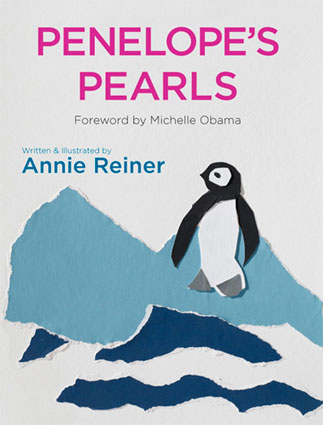 Penelope's Pearls is a seemingly simple story about the transformative power of love and understanding to make us feel whole.
Penelope's Pearls is a seemingly simple story about the transformative power of love and understanding to make us feel whole.Penelope is a very little penguin who can't get used to the cold. One day, she drifts away from home on an ice floe, where she meets another little penguin named Pablo. The magic and beauty she finds through her new friend, opens her imagination and warms her heart. The story is accompanied by unique paper cut-out illustrations. Its clean modern lines reflect the spare snowy landscape, and will please the innocent eyes of children, as well as their parents.
Annie Reiner has written and illustrated children’s books for almost 25 years. As a psychoanalyst, her focus on the states of mind of children and infants has informed her writing for children. We can see the child's most primal pre-verbal feelings and thoughts in adults as well, for how children feel and think is the basis of how we all feel and think.
Reiner's books express some of these basic experiences and concerns of children. Penelope’s Pearl’s reflects the feelings of the youngest children, even small infants, who naturally find themselves in a world less accommodating than the perfectly heat regulated world of the womb. Suddenly he or she is in a world of sensations for which they have no words, and over which they have no control., and for a naked infant it might as well be the Antarctic! The beauty of children’s stories is that they can give words to those wordless experiences.
While parents keep their children warm with clothing and with protective arms, their understanding and love keep them warm inside. As we see in Penelope’s Pearl’s, being able to share our pain with parents and friends has the unlikely effect of transforming pain into a beautiful feeling, as one has the experience of being understood, and held in someone else’s thoughts.
The ability of books to express children’s unknown feelings is one of the reasons they love books, why we all love books. As we know, children also love color, and Reiner's illustrations reflect the simplicity and naiveté of children’s art to speak directly to the child’s experience.
view excerpts...
